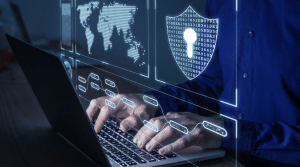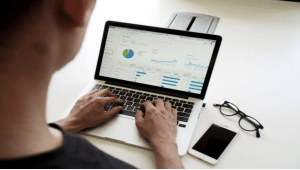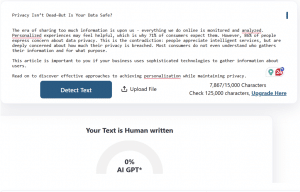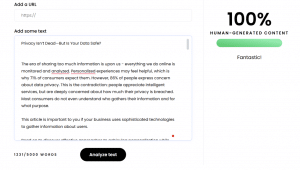
The era of sharing too much information is upon us – everything we do online is monitored and analyzed. Personalized experiences may feel helpful, which is why 71% of consumers expect them. However, 86% of people express concern about data privacy. This is the contradiction: people appreciate intelligent services, but are deeply concerned about how much their privacy is breached. Most consumers do not even understand who gathers their information and for what purpose.
This article is important to you if your business uses sophisticated technologies to gather information about users.
Read on to discover effective approaches to achieving personalization while maintaining privacy.
Why Data Privacy is Everyone’s Problem (Yes, Even Yours)
In the age of constantly being connected with skeletal internet infrastructure, confidentiality is no longer a quandary of big tech alone, but rather something that calls for the attention of everyone. Whether managing an app on a smartphone or running a small business, data is being collected (often without consent) and stored, along with its users. What happens to it when it isn’t adequately protected? For businesses using Veeam, choosing a Veeam appliance by Object First offers a secure, immutable backup solution—perfect for preventing ransomware and safeguarding user trust.
Implications of Irresponsible Data Policies:
- Data breaches: Vulnerabilities on the data store’s infrastructure may result in hackers obtaining critical assets such as email addresses and passwords, along with credit cards
- Loss of trust: Customers could exit once they feel their data is not protected
- Legal trouble: No rules and policies about data privacy result in violent fines and litigations, which could wreck a company in seconds.
In reality, over 353 million people were affected by data privacy breaches in 2023. These are not arbitrary numbers; they represent day-to-day humans who rely on businesses and eventually lose faith.
Why You Should Care:
- 66% of users stated that they would completely shut operations with a firm if a data breach were to occur, and 81% would discontinue reliance on the firm for further operations.
- Miscalculations on the performer’s end could lead to unwanted data being gathered or improperly outdated software being left unattended; mistakes users tend to make create risks.
- Persistent laws, such as GDPR and CCPA, ensure that action is taken, regardless of the scale and power of the business.
A company’s reputation and trust, which aid confidentiality, can be easily compromised. In an ultra-modern world where technology is the word, we know everything.
Now we’ll discuss specific strategies to safeguard user data while still maintaining the relatability and warmth that your audience adores.
The 7 Must-Do Strategies to Keep User Data Safe

These seven actionable steps will help safeguard both your customers and your business.
Use End-to-End Encryption (Your First Line of Defense)
Data being sent and received is encrypted, which means only the sender and receiver can view the original message. Even if interceptors attempt to access the data, private information will always remain guarded because hackers or third parties won’t be able to read it.
Why it matters: Senders and sharers of personal information through forms can be at ease, as no one else has access to what is being sent due to encryption. Such a simple yet potent shield can go a long way.
Use Strong Passwords & Multi-Factor Authentication (Seriously)
Breach of data comes from weak passwords, and yet there has been no change to “123456” or the word “password.” This remains in frequent usage even today, and that poses an alarming threat.
Better solution: Enable Multi-Factor Authentication (MFA) alongside password protection. Setting a code through phone as a secondary form of identification also increases the barrier, ensuring the accounts will be more challenging to breach, even with the passwords. Strong passwords are now a necessity as well—ones composed of a mix of baby letters, numbers, and symbols. ‘.’ Marks the start of strong measures while eluding potential attackers.
Update Software Religiously
Not updating your software can be a dangerous practice. Unscrupulous hackers actively search for outdated software that is vulnerable to known bugs or exploits.
The fix: Updates should be installed as early as possible. Often, these updates defend against an attack that could leverage weakened security systems. These steps are effective.
Limit Data Collection (You Don’t Need It All!)
Collect the least amount of data that is needed. Many companies tend to collect large amounts of personally identifiable data for users “just in case,” which increases potential risk.
Why Less is More: Users appreciate not being asked for information that they feel is unnecessary. Additionally, they mitigate the potential damage that could result from a breach.
Tighten Access Controls Like a Pro
Most employees in your company don’t need full access to user data. Increasing the level of access granted increases the risk of accidental breaches, leaks, or abuse.
Better Approach: Restrict access based on the individual’s position. This is more straightforward, safer, and allows for easier management.
Train Your Team—Because Humans Are Hackable
Most breaches occur because the users chose to take a dangerous action i.e., clicking on a poorly constructed link or entering their credentials on a phishing page.
What works: Teach your people regularly. Train them to identify phishing attempts, create strong passwords, and report potentially dangerous items. A well-trained team can avert threats before they take place.
Back It Up or Risk Losing It All
Data loss can occur due to hacks, system failures, or even acts of nature. Without a backup, all options go out the window.
Your move: Set secure backups to automatic, preferably off-site or in the cloud. Ensure rapid restoration of your data in case things go wrong.
Balancing Personalization & Privacy—It’s Not One or the Other

As you Hyperise, users can create targeted content that is not invasive, which fosters trust, something that is greatly cherished. Personalization doesn’t need to compromise privacy. With the right application, trust is forged. Building relationships is more than just algorithms—when you respect privacy and build a strong shield to data, consumers become loyal in a way that helps retain privacy. The steps to achieve feeling safe start with lowering control, being transparent, and not feeling the need to manipulate users’ data. This is privacy-forward personalization! Truly thoughtful marketing.
Quick Checklist: Is Your Data Privacy Game Strong?
Are you unsure whether your data privacy standards are up to standard? Go through this checklist and see which areas you need improvement in:
- Do you implement multi-factor authentication (MFA)? ✅
- Is your program and the relevant software updated? ✅
- Is the data you collect limited to what is necessary? ✅
- Are backups scheduled and completed on a frequent basis? ✅
- Have your employees completed training drills on data safety? ✅
- Are sensitive data access permissions limited according to user roles? ✅
- Are user data encryptions in place? ✅
If the answer is no for any of these, that is a good place to begin in order to improve your data privacy.
Conclusion
You can’t pick and choose where privacy matters; it’s everywhere. People are monitoring how you use their data, and in a data-fueled world, you need to handle it with care, not just protect it, but be transparent about it. Strong data habits are better than just good practice. They’re the advantage you have over competitors. Start building privacy trust frameworks now rather than waiting for serious data breaches to occur.
Ai report

Plag report

Last Updated on October 21, 2025